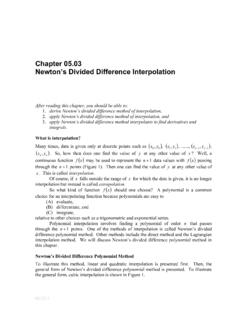Transcription of Facts worth knowing about Oil nozzles - Danfoss Heating
1 Facts worth knowing about Oil nozzles Facts worth knowing about Danfoss oil nozzles Page Contents Oil nozzles and the complete oil-burning plant 3. What is there to know about oil nozzles ? 4. What has a Danfoss oil nozzle to offer? 5. How is a Danfoss oil nozzle built up? 6. How does a Danfoss oil nozzle work? 7. What must be done to the oil to make it burn? 8. But how does the combustion itself take place? 9. What does clean economic combustion mean? 10. What effect has atomizing pressure? 11. What effect has oil quality and temperature? 12. What effect has air supply on the oil burner? 13. Where must the oil nozzle be located? 15. For how long can an oil nozzle be used?
2 16. How should an oil nozzle be handled? 17. Can an oil nozzle be cleaned? 18. What do the numbers and letters on the nozzle mean? 19. How is the correct oil nozzle chosen? 20. Is it possible to compare oil nozzles of different makes 21. What causes an oil nozzle to drip? 22. What makes the flame lopsided? 23. What is the cause of no oil from the nozzle ? 24. What causes oil coke on the nozzle and ignition electrodes? 25. Why shooting start in the flame? 26. What produces a greasy malodorous deposit in the boiler and how can it be removed? 27. Why does soot form in the flame? 28. What causes the oil to ignite with a bang? 29. What can be wrong if there is no flame? 30.
3 What causes leakage between oil nozzle and nozzle fixture? 31. Can the nozzle be the reason for the flue-gas temperature being too high? 32. Can the nozzle cause too low a flue-gas temperature? 33. What makes the flame too long? 34. What causes oil and coke to collect around nozzle and combustion head? 35. Why does nozzle output suddenly begin to vary? 36. What to do with old, worn out nozzles ? 37. nozzle capacities 39. 1. 2. Oil nozzles and the complete oil-burning plant A complete oil-burning plant begins at the oil tank filling connection and ends at the chimney pipe. Every one of the many parts which go to make up the plant must function so that the plant is CLEAN, STABLE and ECONOMIC.
4 Hidden from view at the heart of the plant is a small interesting gadget which looks more like a very nicely done pipe plug than anything else . this is the oil nozzle . The oil nozzle plays a vital role in combustion and it is quite impossible to get CLEAN, STABLE and ECONOMIC plant operation if it is not handled correctly. A technician in the oil burner field will, naturally or to put it more strongly necessarily, know about the function of the oil nozzle and of its significance in the combustion sequence. Fortunately, to learn about oil nozzles it is not neccessary to read for a science degree. Instead, more convenient means are to hand a moment or two, somewhere to relax, and this book.
5 3. What is there to know about oil nozzles ? In general, the answer to this question is, A great deal! However, what is necessary knowledge depends on whether it is the manufacture of oil nozzles or their use is concerned. To make good oil nozzles , a very comprehensive knowledge of the following is necessary: Characteristics of fuel oil and combustion. The nature of atomizing and spray patterns. Oil-burning plant design. Precision machine work. On top of all this, a manufacturer must have a department where necessary and very critical inspection and testing of the finished nozzles takes place. nozzles play an important part in the everyday work of oilburner technicians.
6 That is why it is important for them to follow manufacturers- instructions. In this way they will exploit to the full all the knowledge and experience the manufacturer is passing on through those instructions to gain clean, stable and economic combustion. Even today, there are a great many plants running with poor combustion because of incomplete knowledge of oil nozzles . Such a lack of knowledge can have other unfortunate consequences; attemps are sometimes made to cure faults by changing the nozzle when in reality the faults have nothing to do with the nozzle . 4. What has a Danfoss oil nozzle to offer? Danfoss oil nozzle are known for their high level of quality. Precision manufacture of individual parts and fine accuracy form the basis of Danfoss oil nozzles offer: Perfect atomizing of the oil.
7 Marking in accordance with CEN norm (at 10 bar) and Gal/h (at 7 bar). Four different spray angles. Three different spray patterns. Danfoss oil nozzles also offer high uniformity and two nozzles with the same marking will be identical. This makes life easy when replacing and old nozzle by a new one. 5. How is a Danfoss oil nozzle built up? A Danfoss oil nozzle is a bit more than just a lump of metal with a little hole through it. To be able to meet the requirements of effective atomizing, accurate dosing, and a constant spray pattern and angle, the nozzle is built up of several small fine-machined parts. Danfoss oil nozzles are fitted with the following types of filter: A.
8 Capacity range: B. Capacity range: - USgal/h - USgal/h 45 m sintered bronze filter C. Capacity range: D. Capacity range: - USgal/h - USgal/h 120 m sintered bronze filter 140 m monel mesh filter E. Capacity range: USgal/h and over without filter 6. How does a Danfoss oil nozzle work? To find the answer to this question it is necessary first to take a close look at how the oil travels through the small slots in the nozzle . Oil enters through the filter and continues through the bottom screw and its side holes. From there, the oil runs along the side of the cone and into the cone slots. When the oil, under high pressure, is forced through the cone slots it enters the swirl chamber.
9 On its way through the cone slots some of the oil pressure is converted into rotational energy. In the swirl chamber, the oil gains strong rotary motion and a rotating oil film is formed which moves towards the nozzle orifice. The velocity of the oil film is so great that a tube of oil is formed in the nozzle orifice. With the help of that part of the pressure not converted into rotational energy this oil tube is forced through the nozzle orifice. On be- ing propelled from the orifice, the oil tube is expanded so much that it breaks up into very small oil drops. 7. What must be done to the oil to make it burn Even though oil is rightly regarded as inflammable, it cannot burn in its liquid state, it must first be transformed into vapour.
10 Since oil can only vapourize from its surface, it is necessary to create as large an oil surface area as possible. If the oil is transformed into vapour quickly the chances of clean and effective combustion are increased. If the oil in liquid form is forced through a nozzle with a suitable pressure it will burst into an astronomical number of small drops which, on becoming mixed with the air from the combustion head, will form an oil mist of uniform consistency. The total surface area of all these droplets is very large and it is this area the oil vaporizes from. It is in this way the oil is prepared for combustion, by first atomizing it through an oil nozzle . To better understand this process an example can be given: The amount of oil sent through a Danfoss USgal/h oil nozzle in one hour is transformed into about 40,000,000,000 microscopic drops of oil which provide the very extensive evaporating surface needed for clean and effective combustion the kind of performance demanding a nozzle of high quality and much attention to the way the nozzle is handled.









![Dif In Dif Slides.ppt [Repaired] - Wharton Finance](/cache/preview/e/2/9/5/4/6/1/8/thumb-e29546186543c246a2365bc5cbc8c9a4.jpg)
